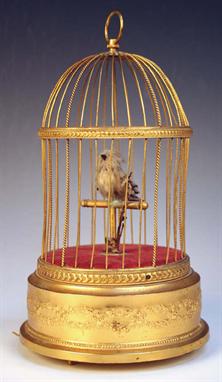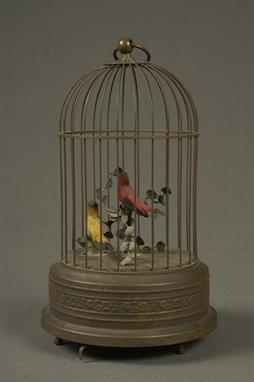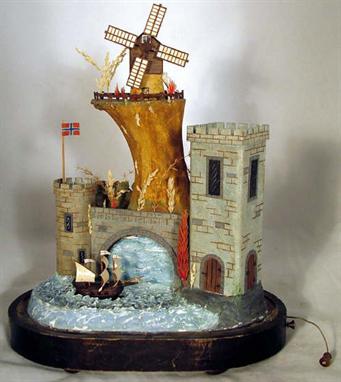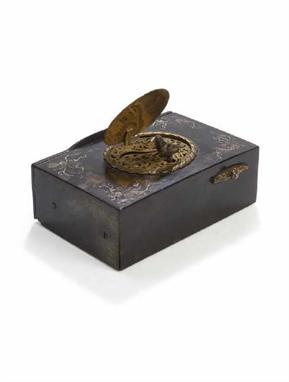We found 4753 price guide item(s) matching your search
There are 4753 lots that match your search criteria. Subscribe now to get instant access to the full price guide service.
Click here to subscribe- List
- Grid
-
4753 item(s)/page
An English early 19th century picture-clock with automaton, painted in a naive hand in oil on sheet iron with an idealised coastal landscape with rustics and livestock to fore, shipping in a harbour beyond, the clock dial (lacks movement) in the pediment of a classical temple, a windmill to the right (formerly with rotating sails) contemporary giltwood and composition frame, 80 x98cm overall ++Lacking movement and hands/sails. The painting with previous signs of old cleaning and restorations. The frame with most of the moulding lost through damp. An object of naive charm
A George III Mahogany Longcase Clock, the arched hood with swan neck pediment above a shaped door with finial, raised upon ogee bracket feet, the painted dial inscribed 'Thomas Wignall, Pendleton', with automaton moonphase movement with Arabic and Roman numerals and with two train eight-day movement striking on a bell See illustration
Singing bird automaton music box having two handles, the rectangular top with oval hinged cover decorated with 18th century style figures with sheep in landscape, opening to reveal a polychrome decorated 'feathered' bird and gilt metal grille, the sides with 'turquoise' cabochon, standing on four paw feet, 16cm wide - see illustration
Ord-Hume - The Musical Clock, Musical & Automaton Clocks & Watches, 1995, dust jacket; Loomes - Watchmakers & Clockmakers of the World, volume II, second edition; Baillie - Watchmakers & Clockmakers of the World volume I; Jaeger Le Coultre - The Manufacturer’s Book of Timepieces; two Miller’s Clocks & Barometers Buyers Guides; Nicholls - Clocks in Coloure; Shenton - The Price Guide to Clocks 1840-1940; together with various DVDs relating to clock repairing
Three Kemplen Automotan related engravings, : "Automaton (Chess-Player)", engraving on paper, foxed, London, published by Thomas Tegg, 1826 § "Chess", engraving on paper, foxed, London, published by Thomas Tegg, 1827 § Twenty Knight's Tours: Chess", engraving on paper, foxed, London, published by Thomas Tegg, 1827.
A Franco-Swiss Bird in a Cage Automaton, circa 1900, the solitary finch-like bird with grey and purple plumage, on T perch within domed cage, the base (enclosing key wind mechanism, the automaton action working (the bellows defunct) covered in foliate embossed brass, and with stop/start lever, 56.5cm high over ring suspension, together with key See illustration
An Impressive Dutch Burr Walnut Inlaid Ship's Automaton Longcase Clock with Calendars and Alarm, signed Jan Hermelink, circa 1760, the nicely figured burr walnut case with moulded shaped hood with central carved bird, (finials missing), "later" pierced front and side frets, trunk with canted corners, long shaped door with inlaid borders and a father time lenticle, curbed base with inlay and raised upon claw feet, 13-inch arched brass dial with silvered chapter ring signed, arcaded minute track, dial centre with rolling moon lunar disc, central alarm disc, month and day of the week apertures, seconds combined with date aperture, the corners with the worlds four continents, automata depicting Neptune’s chariot and ships before a painted landscape background, four pillar movement with anchor escapement, striking on two bells, separate small weight to drive alarm with hammer striking within the bell, levers connected from arbors to operate automata in the arch, (some imperfections to case), 245cm high See illustration Jan Hermelink is recorded as working in Amsterdam in the 2nd half 18th century. See Baillie (GH) Watchmakers & Clockmakers of the World, page 151.
A mahogany eight-day longcase clock with rocking figure automaton Mid 19th century The four-pillar rack and bell striking movement with 14 inch white painted Roman numeral dial with subsidiary seconds dial and bearing signature John Sinkinson, Doncaster to the convex centre, with gilt foliate painted spandrels to angles and scene with rocking horse and jockey to arch, the break-arch pedimented case with twist turned columns to hood above shaped-top short trunk door and conforming columns to trunk, on crossbanded plinth base with ogee bracket feet, dial refinished, 232cm high.
A mid-19th Century mahogany automaton 8-day Longcase Clock, Fisher of Birmingham, the arched hood with swan neck pediments over freestanding gilt metal mounted and reeded columns, to a moulded throat with plain frieze over further quarter columns and short trunk door and panelled base on bracket feet, to a 13 ½” third period painted Roman dial with a rocking ship automaton to the arch over painted spandrels depicting Maidens of the Empire, enclosing a Roman chapter ring with outside minute track, subsidiary seconds and date sector, with pierced and stamped brass hands, to a W Francis false plate, and movement united by four knopped pillars with anchor escapement and strike on a bell (lacking), height 90”
A black lacquer musical automaton bracket clock Paul Rimbault, London, circa 1780 and later The small six-pillar triple chain fusee back-wound movement playing a choice of three tunes via a 2 inch pinned cylinder on eight bells with fourteen hammers on the hour and rack striking the hour on a further bell, now with automaton of parading farm animals operating in tandem with the music, with verge escapement and foliate engraved backplate signed Paul Rimbault, Denman Street, Soho, London, the later 7 inch rectangular brass dial with matted centre within an applied silvered Roman numeral chapter ring with fleur de lys half hour markers and Arabic five minutes with mask and scroll cast spandrels to angles beneath painted country view incorporating automaton to the shallow arch above, the later bell-top case with hinged carrying handle and arched brass fishscale side frets on moulded base with block feet, the whole decorated with raised gilt foliate designs on a black ground, 43cm high excluding handle.
A 19th Century Ormolu automaton mantel clock, with eight day movement striking the hour and half hours to bell, silvered dial, the case front cast with a profusion of scroll work, birds, stylized flower heads and with catyarids to the lower front corners, crested with male and female figures in a gondola like boat which simulates movement on the water, on scroll feet, 23" high
A Chinese hardwood and mother of pearl inlaid automaton bracket clock, early 19th century, the arched case with 5 brass finials above an enamel dial with Roman numerals and centre seconds, the arch with two native figures above striking a bell, the foliate scroll engraved backplate with verge escapement and fusee movement striking on two bells, with nonsense signature, raised on brass paw feet, 60cm high
[Willis, Robert]. An Attempt to Analyse the Automaton Chess Player of Mr. De Kempelen, with an Easy Method of Imitating the Movements of that Celebrated Figure, Illustrated by Original Drawings, to which is added, a Copious Collection of the Knight's Moves over the Chess Board, 1st ed., 1821, 40 pp. incl. half-title, ten litho. plts. incl. frontis., occ. spotting and dust-soiling, ownership signature of F[rancis] Nicholson and his identification of the anonymous author to title, an additional leaf inserted between front free endpaper and half-title with Nicholson's personal account concerning Willis and the origins of the book in his neat holograph, ownership signature of Lewis C. Ingram, 1914, to front free endpaper, orig. boards with remnants of printed paper label to spine, soiled and some wear, upper cover det., tall 8vo Robert Willis (1800-75, architectural historian and polymath): 'In 1820 he went with his sister Mary to London's Spring Gardens to scrutinise Wolfgang von Kempelen's automaton chess player. Having established that there was ample room for an adult to lurk within, mimicking machine intelligence, he published in 1821 an exposé which Edgar Allan Poe passed off as his own in 1836' (DNB). Francis Nicholson (1753-1844) was a watercolour painter who established a large teaching practice from his home in Portland Place. His other varied interests included organ building and fishing. Nicholson's note reads: 'At the time when this analysis was made, Mr. Willis and his sister were my pupils, I am therefore well informed respecting his proceeding. He visited the automaton many times for the purpose of estimating the dimensions of the compartments within the chest behind which the figure was placed. He then caused to be made a similar chest, and copied the parts of the interior. His sister who was full grown entered the chest, and moved through the different compartments. In the prints Mr. W. has given the different positions of the figure by dotted outlines, and has proved the changes to be very easily made and the spaces quite sufficient to contain any middle sized person.' The following three related ephemeral items were discovered inside this volume by the current owner. These would all seem to have come from the library of Thomas Crofton Croker, the Irish antiquary who married Nicholson's daughter, and seemed to share an interest in automata and other mechanical and musical curiosities. (1)
Automata broadside. Maelzel's Grand Exhibition, No. 29, St. James's Street, Consisting of the following unrivalled Automata, viz. The Automaton Chess Player ..., The Automaton Rope Dancer ..., The Automaton Trumpeter ..., The Conflagration of Moscow ..., Admission 2s.6d. Children 1s.6d. each, printed by W. Glindon, Rupert Street, Haymarket, [1818?], orig. printed broadside within decorative border and with woodcut vignette of 'The Turk' being played, faded ink note 'A4' top right, a little overall creasing and marginal dust-soiling, old paper guard to upper margin along edge of printed border, a few marginal small closed tears and small light damp stain to left margin not affecting border or text, 1 p., 255 x 190 mm The Turk was a famous hoax which purported to be a chess-playing automaton first constructed and unveiled in 1770 by Wolfgang von Kempelen (1734-1804). Kempelen first exhibited the Turk at the court of Austrian Empress Maria Theresa in 1770, and later took it on a tour of Europe for several years during the 1780s. Kempelen eventually decided that the Turk was occupying too much of his time and consigned it to a corner of the Austrian palace, and focused on other forms of automata. After Kempelen's death in 1804, the Turk passed through many hands, eventually ending up with Johann Maelzel, inventor of the metronome. He too toured it with mixed success. Eventually the Turk was destroyed in a museum fire in Philadelphia in 1854. No other copies of this broadside have been located during our researches. See illustration on front cover of this catalogue. (1)
[Haddock, Marston]. A Description of Mr Haddock's Exhibition of Androides, or Animated Mechanism, also of the Telegraph, Worked by an Automaton, with Telegraphic Dictionary, &c., n.p., c. 1800, 23 pp., lacks title (pp. 1-2), ownership signature of Thos. Crofton Croker to upper margin of first page and his printed biographical library book label (dated 1848) pasted to final blank page, a little soiling and corner creasing, orig. stitching present, slim 12mo Only two other copies of this work have been located, both copies at the British Library. One is a Dublin printing [1797?] and one a Newcastle-upon-Tyne printing [1800] (full photocopy supplied with lot), but neither is identical to this copy (except in length) and this is either a London or other provincial printing from the period 1797-1800. Marston Haddock was an automaton and organ builder from Cork. Thomas Crofton Croker (1798-1854) was an Irish antiquary who married Marianne, daughter of the watercolourist Francis Nicholson in 1830. After his death at his home in Old Brompton, Middlesex, his library and antiquities were auctioned by his son, two lots of papers being purchased by the British Museum and the National Library of Ireland. (2)
Automaton Exhibition ticket. Under the Patronage of the Emperor of Austria and the King and Queen of Prussia. Napoleon Rooms, Egyptian Hall, Piccadilly, Admit Two to the Private Inspection of Professor Faber's Euphonia, or Speaking Automaton; July 18th, 20th, and 21st ..., [ 1846?], printed circular given to T. Crofton Croker with his name inserted in ink, 1 p., integral blank, horizontal folds, minor creasing and dust-soiling, 8vo. Joseph Faber was born around 1800 in Freiburg, and after a career in astronomy was diverted into anatomy and mechanics. He read von Kempelen's book on the mechanisms of human speech and began work on a talking machine sometime during the 1820s. After some success with a machine in New York and the encouragement of Joseph Henry, Faber pursued the promotion of the talking machine. In 1846 Phineas T. Barnum, following his success with the midget Tom Thumb, talent-spotted Faber's machine, named it the Euphonia and took it off to be exhibited in London at the Egyptian Hall. John Hollingshead described his visit to see it: "I paid my shilling and was shown into a larger room, half filled with boxes and timber and badly lighted with lamps. In the centre was a box on the table, looking like a rough piano without legs and having two keyboards. This was surmounted by a half-length weird figure, rather bigger than a full-grown man, with an automaton head and face looking more mysteriously vacant than such faces usually look. Its mouth was large, and opened like the jaws of Gorgibuster in the pantomime, disclosing artificial gums, teeth and all the organs of speech... One keyboard, touched by the Professor, produced words which, slowly and deliberately in a hoarse sepulchral voice came from from the mouth of the figure, as if from the depths of a tomb. It wanted little imagination to make the very few visitors that the figure contained an imprisoned human - or half human-being, bound to speak slowly when tormented from an unseen power outside. No one thought for a minute that they were being fooled...". Melville Bell, soon to become the father of Alexander Graham Bell, was then working on a phonetic alphabet to help teach the deaf to speak. The Euphonia made a deep impression on Melville Bell and it remained with him when he took his son Alexander, then aged 16, to see Sir Charles Wheatstone. On the back of this meeting Alexander set about building his own talking head, later developing a "Harmonic Telegraph" and it 1876 he developed a working telephone with Thomas Watson. (1)
A part eight day Longcase Clock Movement and Dial, (associated), the dial signed ‘William Draper, Maldon, with silvered and engraved decoration, to a painted ship automaton, titled ‘The Royal George’, over an engraved Roman and Arabic chapter ring, with subsidiary seconds and date sector, to an associated movement with four knopped pillars and anchor escapement, with pendulum bob and single weight
A late 19th century Continental automaton singing bird musical box, the hinged lid decorated with a bird in branches, revealing an engraved pierced grille, the rectangular case overall decorated with Dutch scenes including figures on a quayside, returning the catch and figures feeding ducks, 9.75 x 3.75 x 5.25 cm (ILLUSTRATED)
an unusual extending bannock toasting fork, with indistinct marks for circa 1900, plain three draw sections, lightly engraved BT AT WEEKS'S RT MUSEUM, TICHBOURNE ST. 1038 maximum length 63.5cm, closed length 22.5cm weeks's Museum was situated in Tichbourne St. London and was full of curiosities in the main, one hundred foot long, room. The most notable item which was displayed (1864) was the musical automaton swan, now in the Bowes Museum. The Weeks's Museum later became the site of The London Pavilion (now demolished).
THREE TRAIN MUSICAL MOVEMENT playing seven tunes on a nest of fourteen bells and ting tang strike on the quarters, the 12 brass dial signed Samuel Smith, London, with automaton to the arch of musicians, strike and chime subsidiary dials, the matted centre with subsidiary seconds dial and calendar aperture, pendulum and brass cased weights
An Adam and Eve automaton eight-day longcase clock early 19th century the four-pillar rack and bell striking movement with 12in white painted Arabic numeral dial with arched calendar aperture subsidiary seconds dial and signed Aquila Barker Bristol to centre with gilt conch shell painted spandrels and scene with Adam and Eve standing either side of the tree of forbidden fruit their arms moving with the motion of the pendulum to arch in a later swan neck pedimented case with reeded pilasters to hood above rectangular trunk door and conforming plinth with bracket feet 221cm high overall Aquila Barker is recorded in Moore A.J. The Clockmakers of Bristol 1650-1900 as working from 48 Wine St Bristol 1781-1846
-
4753 item(s)/page




































